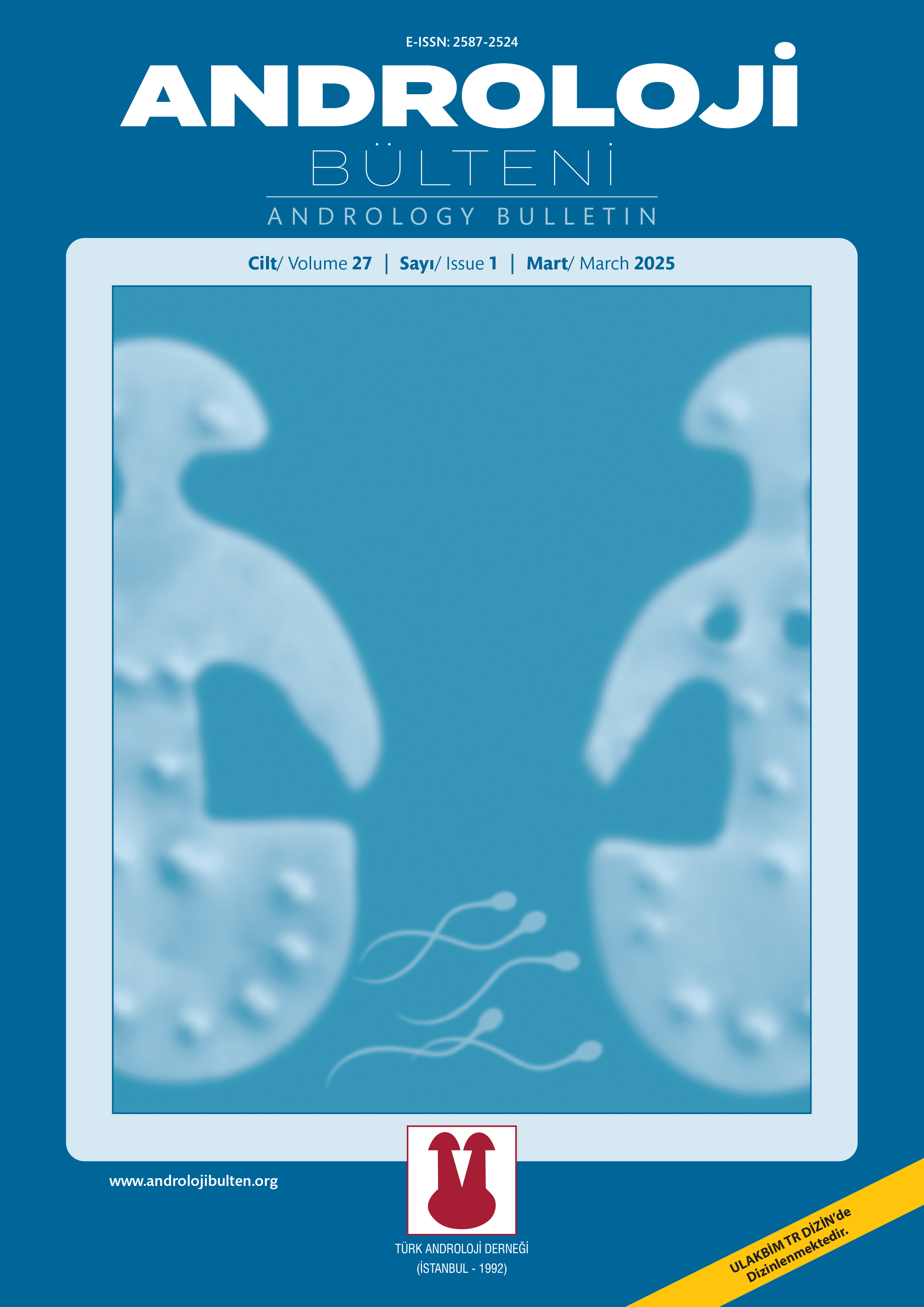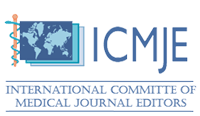INDEXES

Content of this journal is licensed under a Creative Commons Attribution-NonCommercial 4.0 International License.
Volume: 24 Issue: 1 - 2022
| 1. | Cover Page I |
| 2. | Reviewers Pages II - III |
| 3. | From the President Page IV |
| 4. | From the Editor Page V |
| 5. | Contents Page VI |
| ORIGINAL ARTICLE | |
| 6. | Beliefs and attitudes regarding sexual health care of students who take and didn’t take sexual health lessons Nurhan Doğan, Gamze Fiskin, Hatice Yüceler Kaçmaz doi: 10.24898/tandro.2022.67689 Pages 1 - 10 OBJECTIVE: This study was conducted to determine the attitudes and beliefs of students who took and did not take sexual health courses about sexual health care. MATRERIAL and METHODS: This descriptive and correlational study was conducted with a total of 159 students from the nursing (n=104) and midwifery departments (n=55) studying at a university’s health sciences faculty between May 2021 and July 2021. In the study, data were collected using the Student Information Form and the Sexual Attitude and Belief Scale. Necessary permissions were obtained to carry out the research, and the data were analyzed with a statistical package program. RESULTS: Students who took and did not take a sexual health lesson were similar in terms of their socio-demographic characteristics, except for the department they studied. Sexual Attitude and Belief Scale mean scores; It is 38.90±8.00 for students who take sexual health lessons and 37.40±7.90 for students who do not. Most of the students stated that they feel uncomfortable talking about sexual health, they consider themselves partially sufficient in evaluating the information about sexuality and the sexual functions of the individual, and that the sexual health course should be compulsory. There was no relationship between the attitudes and beliefs of the students who took sexual health lessons and those who did not. CONCLUSION: It was determined that the students’ Sexual Attitude and Belief Scale mean score was not negative, and taking a sexual health lesson did not affect attitudes and beliefs. In order to further improve students’ attitudes and beliefs, it can be suggested that other effective interventions be made in addition to the sexual health lesson. |
| 7. | Parents’ knowledge and attitudes and practices about preschool sex education Ümran Çevık Güner, Sare Aktaş doi: 10.24898/tandro.2022.77698 Pages 11 - 19 OBJECTIVE: This study was carried out to evaluate parents’ knowledge, attitudes and practices towards sex education and to examine sociodemographic relationships. MATRERIAL and METHODS: The sampling of this descriptive, crosssectional study consisted of 320 volunteering parents with pre-school children. The study data were collected between January and March 2016 using a questionnaire including parents’ socio-demographic characteristics and knowledge and attitudes about sex education. The data were analyzed on SPSS 17.0 software package using percentage and Chi-square analyses. RESULTS: It was determined that 67.2% of the parents knew the definition of sex education and 29.4% the age of starting sex education correctly. The rate of sex education already given was found to be 41.9%. 45.3% of the parents stated that their knowledge about sex education was sufficient. It was found that the state of knowing the definition of sex education and the age of starting sex education and the state of giving sex education had correlations with parents’ gender, age, education level and job, the profile of the school, family structure, and the gender of children; finding themselves adequate about sex education were correlated with the parents’ age, education and job, the profile of the school, and the gender of children (p<0.05). CONCLUSION: It was determined that the parents did not have adequate knowledge and practices on sex education and that most parent did not consider themselves adequate. It is recommended that sex education programs should be applied routinely in nursery schools so that children’s questions can be answered more accurately with sufficient information and equipment and we can make sure that there are more conscious parents in the face of undesirable events. |
| 8. | Determining the approaches of health professionals on sex education to their children: A public hospital example Yasemin Şanlı, Özlem Şahan, Ergül Aslan doi: 10.24898/tandro.2022.88942 Pages 20 - 25 OBJECTIVE: This study was carried out to determine the approaches and attitudes of health professionals who have children aged 4 and over, regarding the sexual education they give to their children. MATRERIAL and METHODS: The research was conducted in descriptive cross-sectional type. The sample of the study consisted of 203 health professionals who work in a public hospital in the Central Anatolia Region, have children aged 4 and above and volunteer to participate in the study. The data were obtained through the Socio-demographic Questionnaire and the Sex Education Parent Questionnaire. The data were collected by the researcher individually, with the health personnel in the working environment, and by face-to-face interview method. Data analysis was done in a package program. RESULTS: Of the 203 health professionals who participated in the research, 5 were physicians, 153 were nurses, 45 were health technicians, health officers and psychologists, etc. are health personnel. 96.1% of the participants stated that sexual education is necessary for children and 60.8% of them stated that it should be given at the age of 7 and above. 77.8% of the participants stated that they talked to their children about sexual matters, and in this context, 56.7% explained the genderspecific differences in the body. 76.4% of the participants stated that sexual development and education starts in the womb and continues throughout life, 91.1% stated that the first sexual information should be given to the child by the parents, and 57.6% stated that sexual education should be given at school. CONCLUSION: In the study, health professionals stated that the majority of parents thought that sexual education is necessary for their children and they talked to their children about sexuality. It was observed that half of the participants stated that they would generally engage in ‘blocking’ most of their children’s sexual behaviors. |
| 9. | On the idiopathic infertile male patients, level of malondialdehyde, glutathion peroxidase, superoxide dismutase and catalase at sperm and blood plasma, and correlation between them Hüseyin Özveren, İrfan Şafak Barlas, Mustafa Güneş doi: 10.24898/tandro.2022.81557 Pages 26 - 31 OBJECTIVE: In biological systems when the oxidative balance is deteriorated, oxidative stress arises. The increase of oxidants in seminal plasma in the presence of leukocytospermia and varicocele is one of the argumants used to explain the potential losses of these pathologies on spermatozoas. As for the “idiopathic infertility” which forms approximately 30% of the infertility cases; there has been ongoing studies to explain deterioration in spermyogram parameters. In this study, we investigated the relationship of parameters such as superoxide dismutase, catalase, glutathione peroxidase, malatdehidrogenaz on blood and sperm plasma of infertile patients with the sperm parameters as well as the existence of a mechanism that explains this relationship over idiopathic infertility. MATRERIAL and METHODS: In this study we indeed 40 patients that matches the criteria of idiopathic infertility were evaluated. Those who had children in the past year and whose semen parameters fit the WHO 2010 criteria were used as a control group of 20 people. Blood and seminal plasma superoxide dismutase, catalase, glutathione peroxidase and malatdehidrogenaz levels were measured in patient controls and sperm parameters were examined. RESULTS: Total sperm number (67.07±68.182 vs 215±118.743), motility (23.17±20.570 vs 47±10.809) and morphology (50.73±29.274 vs 69±9.119) measurements in the patient group was found significantly lower than the control group (p<0.01). The study suggests that serum and semen malatdehidrogenaz level (7.027±2.0111 vs 10.783±2.8940) (0.9520±0.41292 vs 2.9319±1.43872) of patient group was found significantly higher (p<0.01) whereas catalase level (66.91433±15.300093 vs 15.38145±4.228935) (18.3100±4.0799 vs 10.8451±2.7417) was significantly lower (p<0.01). Serum glutathione peroxidase level (304.14118±200.864744 vs 89.70481±30.178563) of patient group was found significantly lower (p<0.01). Among the semen glutathione peroxidase (8.8590±2.02336 vs 8.9451±2.98786, p: 0.955) and superoxide dismutase levels of serum (8.8590±2.02336 vs 8.9451±2.98786, p: 0.908) and semen (3.3045±1.73632 vs 2.6899±1.80888, p: 0.214), no significant difference was observed between the control group and the patient group. CONCLUSION: According to the results of this study, in idiopathic infertile patients, it was concluded that the decrease in sperm parameters might possibly be associated with MDA and catalase levels. |
| 10. | Investigation of the association between body mass index, classical sperm parameters and sperm DNA fragmentation: A cross-sectional study Semiye Elif Elkatmış, Emre Salabas doi: 10.24898/tandro.2022.80269 Pages 32 - 37 OBJECTIVE: The number of over-weight and obese individuals which increase progressively due to the life style changes in developed countries, became a worldwide problem. Obesity has a negative impact on fertility due to comorbid diseases, hormonal disruptions and over production of free oxygen radicals. Our objective was the investigation of the association between body mass index (BMI), classical sperm parameters and sperm DNA integrity. MATRERIAL and METHODS: Males who had a semen analysis in our hospital were classified into three groups: Ideal weight group (I), overweight group (II) and obese group (III). Standard semen analysis was done in all three groups. Acridine orange was used for DNA fragmentation test, aniline blue was used for maturation analysis, and chromomycin A3 (CMA3) staining method was used for sperm chromatin condensation. RESULTS: There was no significant different between three groups in terms of sperm concentration (I: 55.0 million/ml, II: 64.2 million/ml, III: 47.7 million/ml; p>0.1) and progressive motility (I: 41.0%, II: 42.6%, III: 35.4%; p>0.1), while normal sperm morphology rate was lower in obese group than the overweight group (I: 4.0%, II: 4.9%, III: 3.1; p<0.05). Male in obese group had significantly higher rates of aniline blue positivity (I: 42.5%, II: 40.8%, III: 67.8%; p<0.01), acridine orange staining (I: 44.9%, II: 45.4%, III: 67.2%; p<0.01) and CMA 3 positivity (I: 38.9%, II: 45.4%, III: 65.3%, p=0.001). CONCLUSION: Even if the BMI did not have a significant impact on sperm concentration and motility, normal sperm morphology was significantly lower in obese group. Obese males had significantly higher rates of SDF (acridine orange), protamination defect (CMA 3) and maturation deficiency (aniline blue) than their normal and overweight counterparts. Sperm DNA assessment tests (both direct and indirect) may be suggested to obese males with idiopathic and male factor infertility since there is an association between sperm DNA fragmentation and the success rates of spontaneous pregnancy and assisted reproductive techniques. |
| REVIEW | |
| 11. | Studies examining the quality of life of women in the menopausal period in Turkey: A systematic review Mevlüde Alpaslan Arar, Nülüfer Erbil doi: 10.24898/tandro.2022.69783 Pages 38 - 51 OBJECTIVE: The aim of this study is to describe the studies conducted on the quality of life of women in menopausal period in Turkey and to determine the factors affecting the quality of life of women in the menopause period. MATERIAL and METHODS: This study, which is a systematic review, was conducted between November 2019 and April 2021 by scanning Turkish and English indexes. Studies conducte in Turkey from Google Scholar, PubMed, Ulakbim, Turkish Medline and Dergi Park databases, published between January 2014 and March 2021, published in Turkish and English, accessed full text, research sample of women in menopausal period, “menopause”, “Quality of life”, “Turkey”; It has been scanned with the keywords “menopause”, “quality of life”, “Turkey”. RESULTS: As a result of the screening, 5,363 studies were reached at the beginning. Examinations made according to the title, summary and full text, respectively; After removing duplicate records and examining according to inclusion criteria, 29 studies were reached. In studies examining menopause and quality of life, it was found that regular exercise, vitamin D and bone mineral density levels are effective in preventing the development of osteoporosis and increasing the quality of life; quality of life decreases as the frequency and severity of menopausal complaints increase; positive menopause perception and attitude increase the quality of life; gynecological operations (total laparoscopic hysterectomy and total abdominal hysterectomy) experienced during menopause increase the sexual life quality of women; Genitourinary syndrome in menopause decreases the quality of life of women; It has been found that nonpharmacological interventions (flaxseed, kefir, foot reflexology, pilates exercise) applied for menopausal symptoms improve the quality of life. CONCLUSION: It has been determined that the menopausal period reduces the quality of life of the majority of women, but training, counselling services and non-pharmacological practices for menopause increase the quality of life of women in the menopausal period. |
| 12. | Ferroptosis and male infertility Sercan Ergün, Gulgez Neslihan Taskurt Hekim, Sezgin Gunes doi: 10.24898/tandro.2022.21549 Pages 52 - 56 Ferroptosis is a newly defined form of non-apoptotic regulated cell death characterized by iron-dependent accumulation of lipid peroxide. It differs morphologically and biochemically from known cell death types. Male infertility can have many causes. Although the mechanism of apoptotic cell death and male infertility has been associated with many different aspects, the association between ferroptosis and male infertility is a very up-to-date issue and few studies have been conducted on it yet. Studies have revealed that the unknowns in male infertility can be better resolved by further elucidating the ferroptosis mechanism. In this review, all findings related to male infertility and ferroptosis since the first definition of ferroptosis were evaluated. |
| 13. | The role of sperm odorant receptors and its relationship with infertility Gülsen Zübeyde Karaman, Seda Vatansever, Seda Vatansever doi: 10.24898/tandro.2022.58235 Pages 57 - 66 During the fertilization process, determination of the location of the oocyte by the sperm depends on both physical and chemical cues that regulate flagellar movement. How these signs are detected and how they determine the direction of movement is largely unknown. Odorant receptors (OR) are the receptors located on the cell membrane responsible for detecting odor molecules and they constitute the largest group of human chemoreceptors. Apart from the olfactory sensory system, ORs are also found in various ectopic tissues such as testis and sperm. In order for the sperm to find the oocyte in the female reproductive system, certain chemoreceptors must be expressed on the sperm surface. It has been suggested that these ectopic ORs may have a role in chemotaxis during fertilization. A possible defect that may cause problems in chemotaxis during the sperm’s journey to the oocyte may cause infertility. As it is known, about 50% of infertility causes are idiopathic, and OR defects may constitute some of the possible causes. In this review, ORs in sperm and their relationship with diseases are discussed. |
| 14. | Grafts for surgical treatment of Peyronie’s disease Ekrem Akdeniz, Emrah Küçük, Mahmut Ulubay, Mustafa Kemal Atilla doi: 10.24898/tandro.2022.82687 Pages 67 - 72 Peyronie’s disease is a pathology of uncertain etiology progressing with fibrosis in the tunica albuginea layer of the penis and resulting in calcified plaque formation. These plaques may cause pain and deformities such as penile curvature, shortening, and narrowing. Surgical treatment is the gold standard in severe states in which the clinical course of Peyronie’s disease has stabilized. Three different surgical techniques are applied, depending on the patient’s clinical manifestation, one of these being graft use and penile tunical lengthening procedure. Four types of graft are employed for penile tunical lengthening procedures –autografts, allografts, xenografts, and synthetic grafts. Each has its own specific advantages and disadvantages. The aim of this review is to present the advantages and disadvantages of grafts used in the surgical treatment of Peyronie’s disease in the light of the current literature. |
| 15. | Cardiac conditions and post-surgical sexuality Nilgün Sert, Dilek Aygin doi: 10.24898/tandro.2022.93271 Pages 73 - 81 Sexual activity is an important factor that determines an individual’s quality of life. Patients undergoing cardiac surgery experience many problems such as uncertainty in the time of initiation of sexual intercourse, fear and anxiety due to cardiac effects that may be experienced during sexual intercourse. These uncertainties and concerns cause the patient and his partner to abstain from sexual activity. However, changes experienced during sexual activity are no different from cardiac effects caused by changes in daily living activities and emotional status. Subjects related to sexuality in the world and in our country cannot be expressed by patients due to reasons such as taboos, embarrassment and hesitation caused by cultural characteristics, and they are not sufficiently questioned by health personnel. For safe sexual intercourse after cardiac surgery, cardiac risk assessments, time to start sexual activity, informing couples about the side effects of the drugs used in the treatment, eliminating their concerns and following the treatment process should be implemented. This review article was written in order to review the literature information about cardiac conditions and how sexuality is affected after surgical intervention, and what responsibilities health professionals have, and to raise awareness on this issue. |
| CASE REPORT | |
| 16. | Bilateral complete rod fracture of malleable penile prosthesis Uygar Miçooğulları, Furkan Umut Kılıç, Emir Akıncıoğlu, Orçun Çelik, Yusuf Özlem İlbey doi: 10.24898/tandro.2022.73693 Pages 82 - 84 OBJECTIVES: Penile prosthesis implantation is the gold standard treatment for erectile dysfunction in patients whose first and secondline treatment options gave unsuccessful results. Mechanical failure with a malleable penile prosthesis is very rare. To our knowledge in the literature only one case was reported a bilateral complete rod fracture of malleable penile prosthesis. CASE PRESENTATION: This is the second case in literature reporting a bilateral complete rod fracture of malleable penile prosthesis. We removed the previous pieces and implanted a new malleable device during the same session. CONCLUSIONS: We learned very important lessons with this case; mechanical failure of the malleable penile prosthesis can be seen as a late complication of the surgery. Rod fracture should be kept in mind in the patients who are not comfortable during sexual intercourse. |
| PUBLICATIONS AND CONGRESS CALENDAR OF ANDROLOGY | |
| 17. | Publications and Congress Calendar of Andrology Pages 85 - 88 Abstract | |














